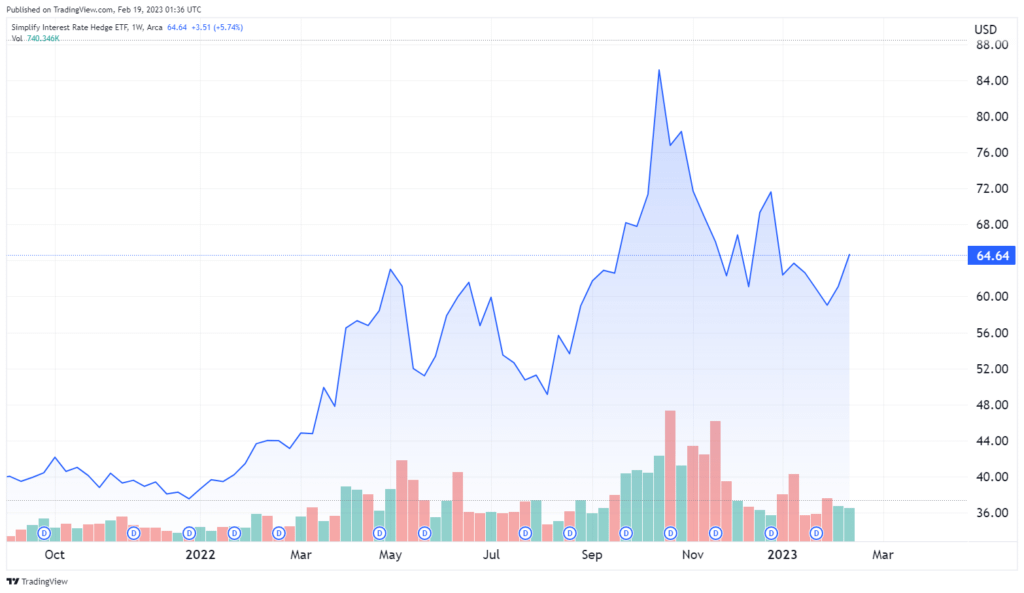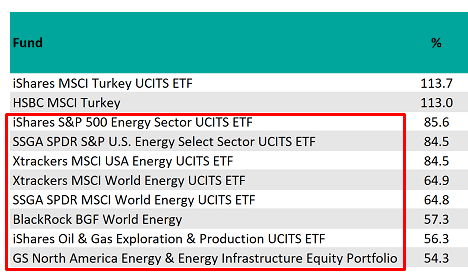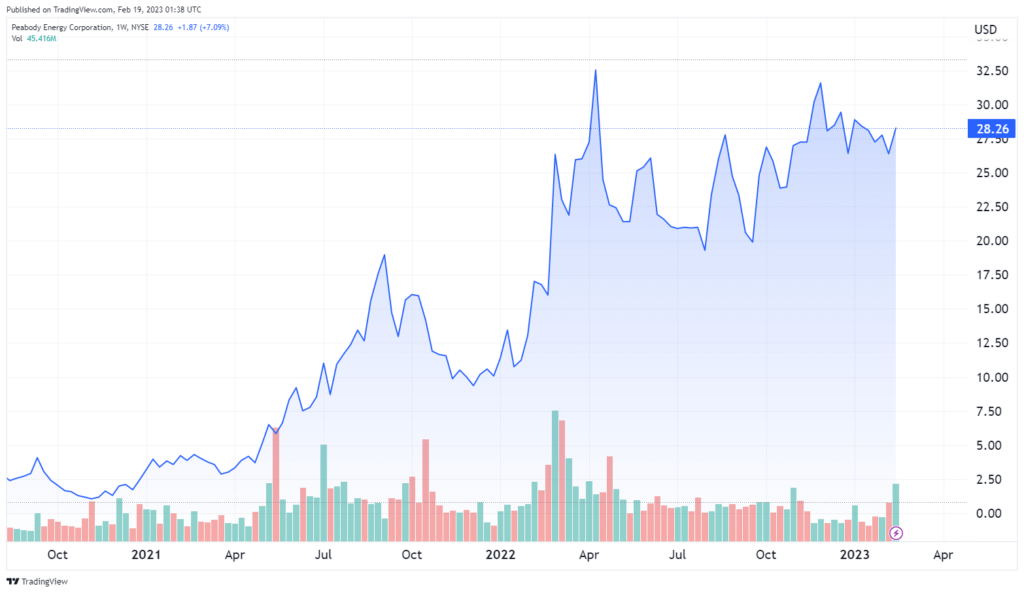2022 was a tumultuous year for the world and financial markets. It was a year dominated by inflation, rising interest rates, high energy prices, and the deflation of an extended bull market.
2023 looks set to be dominated by the same trends. Inflation is still high, and the Fed has signaled that it will continue hiking rates. Markets remain vulnerable.
With many of the influences that dominated 2022 set to carry on into 2023, it’s worth looking closely at the most successful funds of 2022 and the strategies that propelled them to their gains.
3 Top Performing Funds of 2022
Picking the top 3 funds for any period depends greatly on the criteria chosen. Should we include ETFs or just managed funds? Only active or also passive? Only equities or also bonds? Only US or anywhere in the world?
This list is designed to reflect what worked in 2022 and give us a full view of the possible strategies instead of focusing purely on performance on a percentage basis.
1. iShares MSCI Turkey ETF
With 106% returns in 2022, this ETF has outperformed the others by a wide margin. It was followed by a bunch of energy-focused ETFs returning 60%+.

The 2022 performance of the iShares MSCI Turkey ETF comes after a very long period of decline that started in 2012. Part of the reason for the performance was the fund hitting a low of $19.62/share on January 2022.
Some of the 2022 outperformance has faded due to the catastrophic earthquake that recently hit Turkey and Syria, the worst in decades. But this is obviously something that could not have been predicted and does not change the record-breaking returns of 2022.
Increasing trade with Russia due to the somewhat ambiguous position of Turkey in the Ukraine war helped boost Turkey’s businesses and may account in part for the surge in Turkish stocks.
Still, with inflation still not under control and an economy in poor shape, it is not clear if Turkey is out of the woods yet, or if this is a technical rebound in a still ongoing long-term decline. The gains in 2022 were impressive, but there is no assurance that they will be repeated in 2023.
We can deduce a lesson from this fund, but the lesson is not to rush out and buy Turkish shares. This fund staged a dramatic recovery after several years of losses. That doesn’t mean that every losing index will turn around and win, but it does underscore the reality that to buy low and sell high, you have to start by buying low.
Next year’s biggest winner may be languishing in an oversold state today.
2. iShares S&P 500 Energy Sector UCITS ETF
The only ETF that came close to Turkey funds was a fund dedicated to hedging against rising interest rates risk: Simplify Interest Rate Hedge ETF.
It started the year at $37.54/share and went up to $85 in a brief spike, to then decline to then have a second spike just on 31st December 2022 at $71/share.

Inflation has been persistent in 2022, forcing central banks to raise rates. This has been devastating for bond investors and highly profitable for hedges against interest rates.
Inflation has slowed to some extent but remains at historically high levels. The Federal Reserve has signaled that rate hikes will continue, and most analysts expect high rates to prevail through 2023.
That does not necessarily mean that this fund will repeat its performance, but that performance does illustrate the value of locating investments that ride – or hedge against – rising macroeconomic trends.
Energy was the great winner of 2022 among all sectors, with the iShares S&P 500 Energy Sector UCITS ETF returning 85% in 2022. Altogether, energy ETFs represent 8 of 10 of the best-performing ETFs in 2022.

Source: Trustnet
Obviously, the energy war by Russia on the EU was the driving factor, but so was the chronic under-investment in production capacity since the oil price crash in 2014. The rapid shift from tumbling demand and negative oil prices in 2020 to peak demand exacerbated by war put energy in a high-profit spotlight.
Beyond oil & gas, coal also performed very well, with stocks like Peabody (BTU), which almost tripled in 2022 and up 29x since its lowest point at the end of November 2020.

Common Features of Successful Funds in 2022
Recovering Hated Sectors
The common thread between Turkey and fossil fuels is that they are sectors that were deeply hated in 2020-2021 after a long decade of decline and underperformance. Starting price matters, and betting on a sector or country left for dead is often a winning strategy.
Interestingly, this outperformance happened even when the sectors in question were far from fully recovered. Turkey’s inflation was 64% in 2022, and oil prices have struggled to stay above $80/barrel despite repeated production cuts by the OPEC+ cartel (OPEC + Russia). They might still have potential before the trend reverses.
Macroeconomics
The other theme of 2022 was the return of macroeconomic risk. Both energy and inflation made a dramatic comeback after years of being irrelevant. The war in Ukraine, but also persistent underinvestment in commodities and infrastructure, played a big role in causing it.
This might still play a role in 2023, but with likely subtle variations around the same theme (see below).
Investing Ideas From The Lesson Of 2022
1. Buying When There is Blood on the Streets
The first idea is to look for sectors that are out of favor, with persistent losses for years, ready to turn around.
One possibility is cannabis, which has gone from low to lower for a while now. This is a vector that we covered recently in this report.
Another one could be Chinese tech. It has recovered a little from the lowest points but is still far from recovered. Some sectors of international or US tech might be also getting low, but they would not really fit the bill of “hated for years” as they all reached all-time highs in 2021. So for recently down tech, if their growth profile is still intact could be a good move. The next Stock Spotlight report will cover such an e-commerce company.
The most daring investors might even want to test their luck with really risky bets like Ukrainian stocks, certainly trading at a huge discount (justified, in my opinion). I would, however, not want more than 5% of a portfolio on this idea.
2. Persistent Trends
Energy
This might sound paradoxical, but when a 10-year-long trend reverses, it usually takes time to run before losing steam. So we could expect energy or inflation-driven investing ideas to work as well in 2023, even if maybe not to the extreme levels of 2022.
This is something we will discuss in an upcoming report looking into a company involved in the logistics of gas transportation to the EU.
Inflation
Inflation is a more tricky question as it hinges on so many variables:
- Central bank decisions
- Supply chain issues
- Energy costs
- Geopolitics
Because of the inherent incertitude in predicting any hyper-complex macro data point like inflation, I would not recommend going all in on this topic. Keeping an eye on its potential effects, both positive and negative, is nevertheless recommended.
3. Black Swans and Hidden Risks
What may be more relevant is looking at macro risks that markets are dismissing too easily. The world was complacent about “transitory” inflation for a while. Something similar but unrelated to inflation might play out in 2023.
Maybe an intensification of the US-China tensions is something that’s not getting enough attention. If the recent panic about spy balloons shows us something, it is that both countries’ defense and intelligence communities are on the edge.
Trouble in the Middle East is also an option, with the recent mysterious bombing of military factories in Iran. Food prices could become a global issue if the Ukraine situation continues to deteriorate.
4. Something New and Unpopular
The investing principles illustrated by the success of the largest funds can be deployed at a smaller scale. An off-the-radar country or a single company out of favor can provide good returns if the fundamentals have turned around, but the markets have yet to realize it.
This can also include very large companies, with Tesla, Meta, Warner or PayPal down by more than 60% in 2022 and among the top 20 worst-performing stocks for the year.
Keywords like “worst performance,” “crash,” “sinking or tanking markets,” or “death of X” could be good indicators of something ready to rebound, if not for 2023, then 2024. The key is to avoid or at least manage the potential value traps:
- Danish Stocks Are World’s Worst Performing in 2022 Rotation
- Forget Crypto Winter. In Biotech, It’s Been Freezing for Months
- 2022 was the year crypto came crashing down to Earth
- The cannabis collapse: Why weed stocks are crashing again
- Tech’s reality check: How the industry lost $7.4 trillion in one year
- Petro’s Dividend Taxes May Almost Kill Off Colombia Stock Market
- Brazil Markets Sink as Traders Mull Lula’s Plan to Beef Up State
Conclusion
With hindsight, it is easy to claim energy would be the winner of 2022. All it took was correctly predicting the invasion of Ukraine, the problem of a global underinvestment in production capacity, and China ending its COVID policies. Not many analysts got even one of those right, even less all.
As the saying goes, “predictions are hard, especially about the future.”
This is why portfolio construction, risk management, and margin of safety are such important concepts. For example, tech investors that took some chips off the table in 2021’s all-time highs are probably okay. So are investors in emerging markets that took distance from Russia early enough.
The trick is not to let caution turn into fear or paralysis. The too-good-to-be-true prices of energy stocks in early 2022 were NOT a mirage. Fast-growing and profitable tech companies are likely still a good deal, irrespective of recent price actions.
Maybe Columbia or Brazil will be 2023’s Turkey (we just published a full article covering Brazil’s risks and opportunities). Or Biotech turns around when no one pays attention to it.
Stock pickers willing to do the work can look for the intersection of several trends. South American energy companies, biotech specialized in cannabis, Danish tech companies, any combo that might make sense and detect a bombed out price for an otherwise good company.
Of course, there are no guarantees – there never are – but when markets are beaten down, there will be opportunities. Looking at what succeeded in similar conditions can help!
Learning from Markets
These articles look at recent and not-so-recent market history to learn timeless investing lessons. It will also thrive to articulate these lessons into ideas or trends relevant to today’s markets and investment strategies.
The post What We Can Learn From The Top 3 Performing Funds of 2022 appeared first on FinMasters.
FinMasters